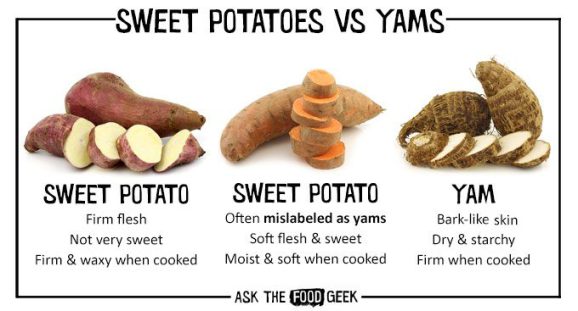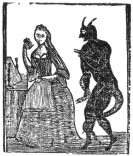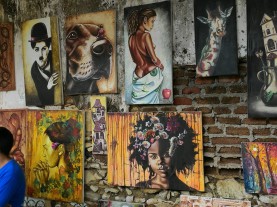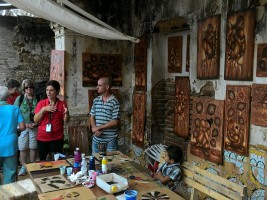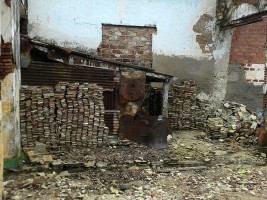Have any comments or thoughts on any of the postings in this blog?
Feel free to email me at: smalone@stevenspen.com
2018
Yam vs. Sweet Potato
They Are Different
I Didn’t Know
Steven D. Malone
My son’s request: a yam casserole buried under tiny toasted marshmallows.
Yam or sweet potato. They’re different things.
I didn’t know that. And, most likely, neither you nor I have eaten one of them. Do you know which?
Brief aside: Thanksgiving is here. My belly growls in its anticipation. Got a deep fried Cajun turkey coming. A first for us. Fresh green bean deep dish with cream soup and almonds. A relish tray with lots of green onions, gherkins, with Greek and green olives. I also get to sneak in my favorite, brandied pecan pie. That’s pecan not pee-can if you please.
We’ll skip the rest. It’s a belt size issue.
Sweet potato or yam. What is the difference?
Got to see a lot of big words while searching for the difference. Angiosperm, monocot, Dioscoreaceae, convolvulacea, ipomoea batatas. I’ll skip those.
What I’ve been calling a yam is in fact a sweet potato.
Though they are not related they are both flowering plants and tubers. That said, yams are related to lilies and grasses. Sweet potatoes are related to the morning glory.
True yams are starchier, drier, with a whiter flesh, and have a rough, bark-like skin. Sweet potatoes, like I get in the grocery, have smooth skin that is usually reddish brown, and is moist and orange-red on the inside.
It turns out that they differ greatly in nutritional value as well.
I didn’t know that.
Compared with yams, sweet potatoes are lower in calories and have far more beta-carotene (11.5 compared with 0.07 milligrams for each one-half cup), an antioxidant nutrient thought to guard against certain cancers. That consuming three to six milligrams daily will maintain blood levels in the range that's associated with a lower risk of chronic diseases. One-half cup of sweet potato supplies double that amount. Sweet potatoes also have a lower glycemic index number than yams, meaning their carbohydrate is released more slowly into the bloodstream.
Yams, however, are nutritious. They are a good source of fiber and potassium.
Eat both with the skin.
Sweet potato, 1/2 cup, baked with skin, have 90 calories, 0 grams fat, 20 grams carbohydrate, 3.3 grams fiber, 2 grams protein, 475 milligrams potassium, 20 milligrams vitamin C, 0.28 milligrams vitamin B6, 11.5 milligrams beta-carotene.
Yam, 1/2 cup, baked with skin, have 116 calories, 0 grams fat, 27 grams carbohydrate, 4 grams fiber, 1.5 grams protein, 670 mg potassium, 12 milligrams vitamin C, 0.23 milligrams vitamin B6, .07 milligrams beta-carotene.
The above information is a copy/paste. I don’t know how they end out in my body but I know I like to have fiber, protein, beta-carotene, and vitamins C and B6 in there.
Mostly, you will get sweet potatoes in the store. They will probably be listed as yams even though the U.S. government recently required a note that they are actually sweet potatoes. You might try the imported foods section to find true yams.
So, now I know.
Happy Thanksgiving, ya’ll. Enjoy the only secular holiday on the calendar.
Feast. Indulge. Nap.
Then go workout.
Happy Halloween!
I thought I would reprise an old blog post for this most haunted of nights. In a time of my misspent youth I had occasion to meet, and get to know, the Devil. The Devil and his lady. Enjoy.
The Devil and his Lady
A Confessional Character Study from the Sixties.
I had the rare privilege of meeting and getting to know the Devil back in the winter of 1968-69. He is not the man most think he is. He does not look as most think he does.
His lady – well, she kind of is, and kind of is not, what most would expect.
The Devil, contrary to popular belief, would not come knocking at your door. You went knocking at his. That was how I met him. Way back then, my friends and I came to the city on the hunt. We hunted all those things young men hunted in the sixties. Our city friend told us where to go, for he had a friend who had a friend who had a friend who knew and each told the other. Then my friend told me.
In this city, the gate of Hell was in a blighted area of town just southwest of the downtown skyline. We walked into it with a creepy, goose-pimply, sense of dread and wonder. Large, blocky, washed-out, tan, apartment buildings seemed to stare back at us, broken out windows and doors, black and rigidly empty like the eye sockets and maws of so many skulls. The ponderous hulking smothered the sounds of the surrounding city and even smothered the usual Texas breeze. It smelled of old stone, old wood, and old air, a dusty, stale, silent musk.
The quiet whispered; why are you here?
There were people there, denizens really. We felt them more than saw them. They watched. Strangers, intruders maybe, invading. I supposed they wondered if enemies or friends approached. Then the Devil emanated behind us, perched on a stone bannister shouldering a ponderous stairway leading up into one of those haunted edifices.
The Devil’s name was not Satan or Lucifer. That’s bad for business. I’m hazy about the name – my friends, too. But it was John or Frank or something innocuous like Eden or Travis.
Why is it that I’m so vague about the name of the Devil?
This man was the Devil and I would learn that soon enough. I expected the stereotype – swarthy, narrow and chiseled face, glare and snarl. Not the truth. He looked Irish or Nordic with golden hair, like new copper, cut short and with tight curls. His face was round and pleasant looking with full lips smiling pleasantly, pale eyebrows, and a gentle plump nose. A good build, comfortably stocky, with no hint of fat. Of course, his eyes marked him. They glowed the color of an iceberg but promised trust and cold honesty. His gaze held invitation not avarice.
Then his lady stood with him, as if she stood beside him always. Where did she come from? She was not there when first we saw the Devil. I did not think about that until this moment.
The Devil’s lady stands, to this day, as the most beautiful woman I’ve ever seen. Mix Angelina Jolie, Cote De Pablo, and Karina Lombard into a Mexican magnificence that is more of a Castilian courtesan than a Salsa singer. The blackest gossamer hair glistened even in the shade. The blackest gossamer eyes glittered even in the dark. A generous full mouth smiled both welcome and promise. Voluptuous curving body, neither skinny nor plump, that wasted not a handful of anything important. Long woman’s legs that started here and went all the way to the… Well, one of those luscious legs went from here all the way to the floor. The other went from here all the way to a clubbed foot. The Devil marked his property. The ancients believed a clubbed foot was the mark of a Devil’s child. That’s how I knew him for what he was. That is how I knew what she was. Despite the mark, all of us loved her – worshipped her – in all the unrequited passion possible in young men.
Her name was – what; Isabella, Juanita, Carmen - why is it that I’m so vague about the name of the Devil’s lady’s?
The Devil is a provider. He is the provider. Our man, the Devil, provided. He provided anything and everything anyone could want or dream of wanting – anything good, anything bad – just ask. That anything you asked for turned out to be of the highest quality and at the best price. And, truth, no strings attached to that anything – ever. The Devil never, while I knew him, ever came sneaking up behind me to whisper in my ear. One always went to him to whisper into his.
I give you my personal guarantee; we pave our own way to Hell.
So, we always came to the Devil’s apartment, in that skull of a structure, seeking our hearts desire. The Devil’s lady greeted us at the door with her warm hospitality and warmer promising smile. I remember she always offered green tea and cookies she made, as well as other, free, hippie delights. Astute, informed, and witty conversation emanated from her beauty as we basked in her glow and ruminated about war, world affairs, and revolution. Then the Devil arrived to hear our wants and needs, just so happening to have each and everything just on hand – at just the right price and at the highest quality. We always left content and completed, remembering to look back at the beautiful Devil’s lady.
If there is one unchanging universal fact it is that the universe changes.
And the world did turn. Rock became acid rock. Marches became protests became riots. Love became hate. Experimentation became addiction. My hair grew and grew. Waitresses refused to serve me. Cops sought me out for car searches. People’s stares on the street became glares. My friends began to come home dead from Nam or drug dens or mysterious unknowns. Where did all these enemies come from? I hated no one. I just wanted to live my indulgent life and let you live yours.
It was time to leave the city, return to what we called in east Texas ‘behind the pinecone curtain’, and chase girls and keg parties. A low profile was best. This I did. In that quiet, my spirit and spirituality found me out again, quieting my soul. Allowing me to grow up.
What used to be the haunted neighborhood where the Devil lived is now an elevated freeway though the no man’s land below it seems just as haunted.
Where the Devil and his lady went I never learned. I am free of him now, and it was easier than I expected. I am free of her now, though it was harder than expected. Vivid images remain – fleeting things surrounded by shadowy hazes.
Why is that so vague?
Why We Need Story
By Steven D. Malone
Once upon a time, a dark and stormy story voiced. I listened.
Many stories actually. My soul filled with them. The walls and shelves groaned under the burden of their weight.
Once, in my immeasurably misspent youth, I hitchhiked home from San Francisco to Houston, Texas carrying 30 pounds of boxed books alongside a duffle and a backpack. I would have ditched the duffle before I let go the books.
I carried this weight because I need story. Always have. Always will.
I’m not alone in this I think. You need story. We all need story.
This need birthed itself, in a which-came-first-the-chicken-or-the-egg way, the day the first Pleistocene caveman lied to his hungry family about the big one that got away. With appropriate embellishments, of course.
“If you’re going to have a story, have a big story, or none at all.” – Joseph Campbell
Somehow, story making and telling is wired into our very brain. Right alongside the mind’s ability to use language. Like a sort of Language 2.0. A “meta-grammar”, if you will. Our minds may be a “story processor, not a logic processer” – says Jonathan Haidt. And story hugely profits our species.
We might not recall facts, but story has a way of embedding into our minds and remaining with a tenacity only rivaled by music. – Kristen Lamb
In my heart I feel that telling and listening is just plain fun. There need be no other purpose. However, I find that way too many experts tell me that it has other, more profound, purposes.
Storytelling gives our species a leg up on the food chain scale. By itself, the ability to tell stories may be an evolutionary step separating us from other animals. It’s damn useful.
It can tell us how our world works. It shows us valuable information on tool making and use. How to bag the big game. How to make fire. How to hide from the lion. It tells us about our tribe, the history of its heroes, and how our tribe is better than other tribes. Story unifies us, reaffirming tribal truths and strengths. What better ways are there to account for the triumphs of our tribe?
Laura McGuire, https://www.philosophytalk.org/blog/evolution-storytelling, speculates that stories help us avoid our troubles by allowing us to enter imaginary worlds. To relax and escape our reality. And, maybe, it gives us an advantage in finding a mate. Tell a good story, hold another person’s attention, and seduce them with our words.” (I like that last one especially.)
She reinforces the idea that our mythologies and histories, shared, provide pooled resources that make the group stronger.
They tell me what we do and how we live and occasionally, if I’m lucky, they tell me why. There is a commonality to stories that makes us whole beings…” - Pete Sleeth
So, what is a story?
Piper Hendricks says: A story is “a character-based narration of a character’s struggles to overcome obstacles and reach an important goal. Stories convey values. In each of the five stages of a well-told story, different chemicals are released. A “well-told” story is one that reaches your audience. You will only reach your audience and transport them into the world of your character if they relate to the character. A good story conveys values, emotion, action and creativity.”
Well, I think he overstated what a story is. A little anyway. Something got skipped as well. What, to me, was left out was that a story “reaches your audience” because it entertains. It’s fun. That’s the way those chemicals get released.
Empathy.
A reader, a listener, needs to insert him or herself into the character. To hear Genesis, one must taste that apple. In The Lord of the Rings, you must feel the weight of the ring.
We humans, I believe, are addicted to vicarious living through tales told or read. Through all the eons, our species struggled through situations we must decipher or escape. This struggle, in times of rest, leaves us with a yearning. It does not let go. An itch that needs to be scratched.
We want more. In the dark of our cave, before the flicker of the hearth fire (or the TV), we seek more. We reach to open a book. We grab the remote. We yearn to relive (vicariously) the adventure of our lives.
Open a book you crazy guys. We need it. Scratch. And, maybe, live happily ever after.
Here's where
Cuba? Why Cuba?
Part IV
CUCs, CUPs, and Creation
Making do. Making do with what one has often enough. Creation from things at hand. That impressed me most as I wandered over the Island. Signs of this genius showed throughout the countryside and throughout eras.
This is a mailbox. They decorate buildings hundreds of years old. Need a mailbox on your wall? Why not do it up right? I’m told they are still in use.
Even if you’ve got nearly nothing.
Cuba operates under a dual currency system. She has done this since the “Special Time” forced an opening of Cuba to tourism, a beginning of private businesses, expanding agriculture endeavors, and other reforms. The Special Time (a time of extreme hardship) followed the collapse of the Soviet Union that ended Russia’s subsidizing Cuba. Made worse by the continuing US embargo.
Cuban citizens have wages and prices set by the Cuban peso (the CUP), while Cuba’s tourist economy uses the Convertible peso (the CUC). The CUC is paired, 1-to-1 or nearly so, with the US dollar. At the time of our visit, a CUC was equal to 24 CUPs. In a government-run store (vastly “superior” to the citizen’s bodega), I saw pretty blue British bicycles costing about 120 CUCs or 2,400 CUPs.
I wish I had a better picture but I was more interested in the sheetrock sold for recovering from hurricane damage than I was in the bikes.
Most Cuban families rely on the “Libreta de Abastecimiento” (literally, "Supplies booklet") for their food and other needs. These are government subsidized products that are available at the local neighborhood bodega. This bodega is a convenience store that supplies everything from meat (at the “carniceria”), groceries, cigarettes, matches, fuels for cooking, even home supplies such as lightbulbs.
Products vary according to age and gender. Children below the age of seven, the elderly, the ill, and pregnant women get a litre of subsidized milk per day. When we visited the bodega, families could get five eggs per person per month. The eggs lay stacked on cardboard trays and were carried from the store in plastic bags that customers brought in. Bread, in the form of what looked like large wheat buns, are distributed daily. I saw these stacked in a huge glassed bin as I entered the bodega. Behind the counter, shelves displayed meagre amounts of things like flour, dry baby formula, canned beans, and some feminine products. Huge sacks of Vietnamese rice lay on the floor.
This is the “Kelvenator” holding refrigerated items. It must date from the 1930s, if not earlier. See the eggs and sacks of rice.
In Cuba, you don’t waste what can’t be replaced.
There does exist a “Mercado negro”, a black market in Cuba. Often called a “por la izquierda” – by the left hand. But this may merely mean items sold by unlicensed vendors (like a fisherman’s catch or home-made things).
The Art of Making Something from Nothing.
That “art” impressed me more than anything else I saw on my tour. With few other choices, these islanders must make do with what they had. Low wages under acute, communal socialism. Removal of Soviet subsidization. The American Embargo. Marine isolation.
Necessity breeds creation. Nothing goes to waste.
Note the herculean effort, used parts harvesting, and shear mechanical genius that keeps all the old cars on the road and looking good. Note the reinvention and repurposing that turn bicycles in to canopied, three-wheeled pedal taxis. Note the ever-increasing plethora of hypermodern, organic farming you may see tucked, here and there, among the forests (Cuba begged assistance from Australians and others “not embargoed” to help and train its citizens for this). Note the technology repair shops dotting every town, where parts are pirated from broken cell phones and computers to repair what can be repaired.
The best glimpses I got of this necessity came from the cigar factory and the several “artist colonies” we visited.
The time honored art of cigar rolling probably remained the same since the beginning. The Cuban “twist” at the factory famous for the top tier Montecristo, shows both a communal spirit and the art of making do. People seek out and wait in line to get hired for this repetitious job. The company bosses make a great effort to keep their workers happy in it. A hungry workforce – a company café. No piped in music or diverting widescreen TV – dig up an old PA system and have someone read books while the workers work. Tolstoy and Tolkien. Rowling and Hemingway. They cheered us when we interrupted their work day and they found out that we were from the US.
The Cubans are born and bred artists. We visited a world class dance troop. College aged kids that rehearse six hours a day and get to tour the world. They share this art with the children of the neighborhood.
College aged guitarist and violinist serenaded us at lunch with old instruments and skills they learned from parents and school.
An art colony, for lack of another term, that created sculpture from car parts, abandoned bricks and stones, and leftover house paint. It housed itself in an uninhabited water tank they refurbished themselves. They altruistically teach art, music, and dance to neighborhood kids.
An artist that makes paint from muds of various shades and of coffee grounds. He also teaches his skills to neighborhood children.
He does his art in an abandoned apartment complex lent him by the government. Look right to see his work displayed.
Look left and see what looks to be a bomb crater. You make do with what you have.
<< New text box
I did not see any unhappy Cubans during my tour. Figuring that the one’s we visited were selected for that, I did get to roam the streets freely. Only saw one child cry. She fell and skinned her knee. Only a few look ragged-poor. But they sang in the nights, visited and gossiped with each other, played chess or made music with each other. They displayed pride in their accomplishments and looked hopefully at us wanting us to recognize those accomplishments. Many times, on the streets, Cubans shouted their patriotism and were glad to find Americans visiting their island. They kept up with our politics. They followed our sports, especially baseball, and they knew the Cuban expats that played the game.
Cuba was not an armed camp. No camo wearing, machinegun toting patrols walked the street. No checkpoints. I didn’t even see all those huge propaganda posters of revolutionary heroes or the latest president I expected. We passed three or four military complexes. Small affairs of unimposing buildings and landscaped lawns. An easily spotted pair of uniformed guards walked an ambling sentry and these appeared unarmed. But for that handful of policemen, I saw at the airport, there was no great police presence. We Americans are more stridently policed than are the Cubans.
Many on the streets wanted “normalization” of relations with the US. None showed any resentment toward us.
Those are my observations of Cuba. I know a week is a blink in time but I saw what I saw and felt what I felt.
The previous entries of this series can be found in the 2017 Archives. Link to them from the column on the upper right of this page.
If you have any thoughts or questions about what you read on this blog, feel free to email me at the address listed at the top of the page.

